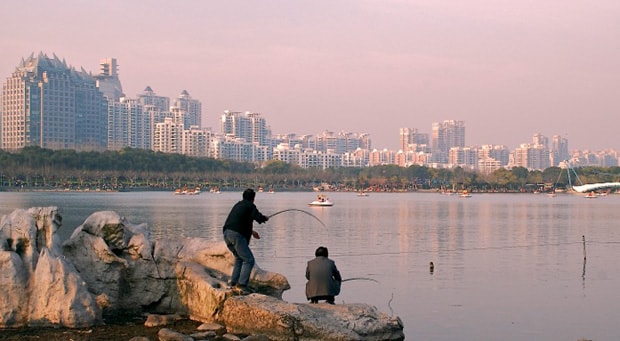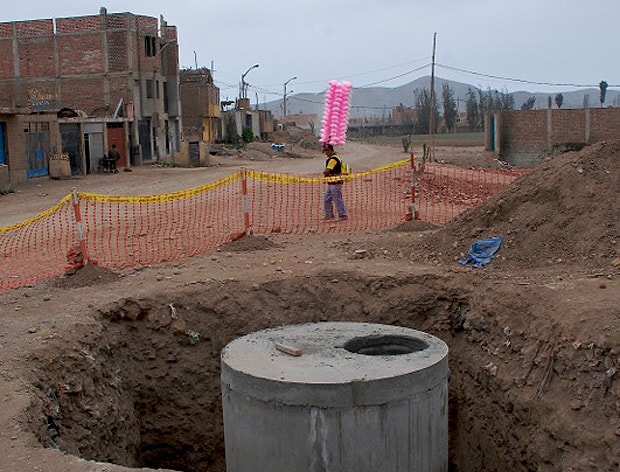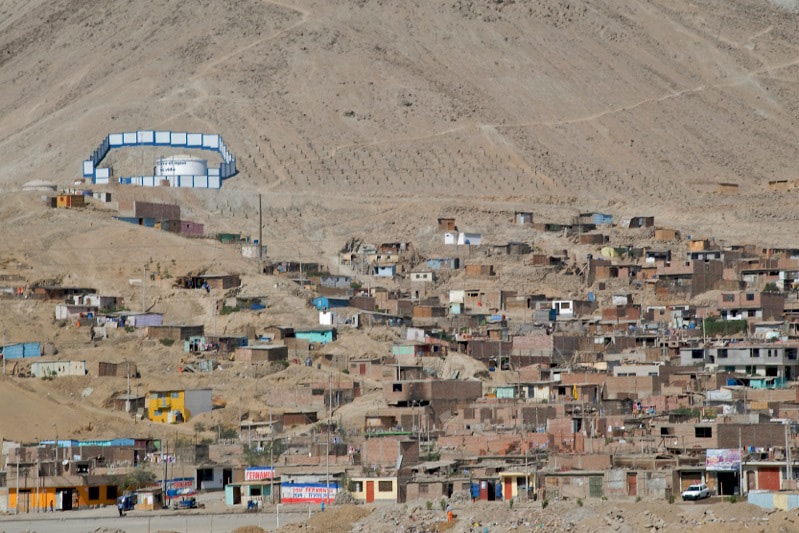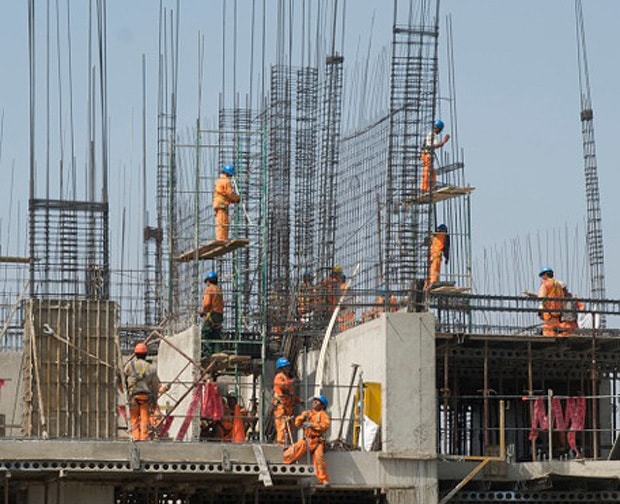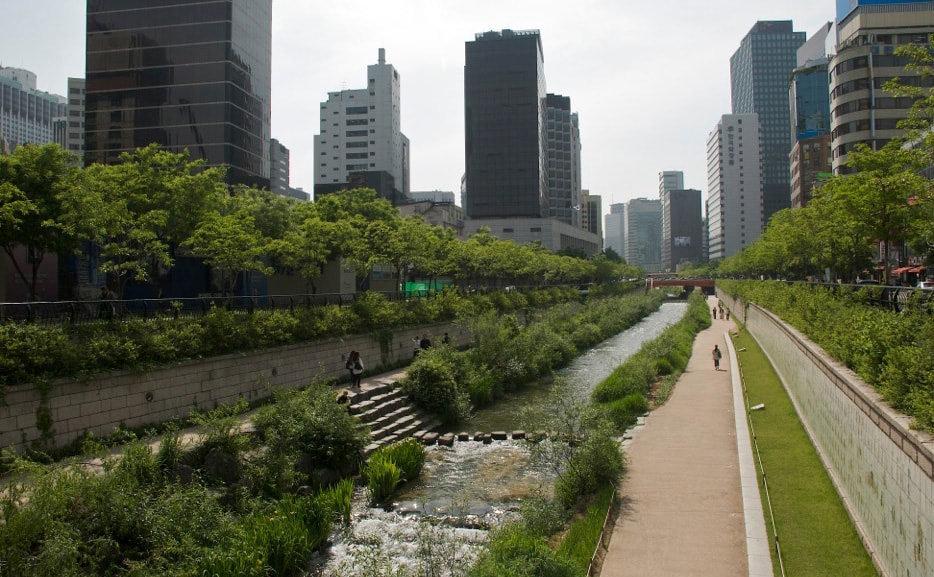Intro
The next generation of urban infrastructure will not be built. This is to say, that a sustainable future will not come from new technologies. Urgent demand is already overwhelming adequate risk management and urban governance capacities. While indeed carbon-free light rail, driverless cars and desalination plants will be in unquenchable demand, none of it will happen successfully without a bankable environment that aggressively manages the social, political, financial and environmental risks of new infrastructure. The barriers to the next generation of infrastructure [1] are neither technical nor financial; rather they’re social and political. Effectively responding to the unprecedented need for urban infrastructure hinges on the successful process over the high-tech outcome.
Shanghai, China. Image © Scott Muller
New Urban Dynamics
Cities have replaced national governments as the de facto drivers of global economic growth and human development. In fact, 300 of the largest metro economies worldwide, containing just 19% of the world’s population, delivered nearly half of the global economic output in 2011 [2]. A recent analysis by the McKinsey Global Institute reveals that by 2025, more than two thirds of global GDP will be produced by just 600 cities – the majority of them in emerging countries [3].
But importantly, economic growth does not alone create stability. Spanning from the least to the most developed, the fate of cities is one of increasing vulnerability to climate change, resource scarcity and rapid population growth.
Chorrillos, Peru. Image © Scott Muller
Hyper-Urbanization
By the year 2030 world urban population will increase to nearly 5 billion persons (1.35 billion more than present), increasing the planet’s urban area by an astonishing 150% in less than 20 years. Sixty percent of the area to be urban by 2030 has yet to be built [4]. Contrary to the trend of the 20th century, the majority of this urban growth (and commensurate economic growth) will occur in developing countries and mainly in second-tier and lower cities. From now to 2030, the world will need to build the equivalent of a city of one million people in developing countries every five days. Their intense demand for the rapid construction of new infrastructure threatens their already challenged risk management and urban governance capacities.
Nexus Issues
Incongruous to this rapid urbanization, is the reality that current growth is no longer supported by sustainable inputs, as we are already 50% in “overshoot.” In other words, human systems are presently using 50% more than the annual productivity and assimilating capacity of the planet’s ecosystems [5]. This unsustainable consumption of ecosystem services to subsidize the growth of cities is progressing ever farther along the urban-to-rural gradient. One result is an ominous energy-water-food nexus of demand confronting city, regional and national decision makers.
As urbanization reaches farther beyond its geopolitical borders to satisfy ever-greater metabolic demands, rural communities and families are linearly assimilated into “foreign” urban economies, with marked social and cultural impacts. Families with rural legacies can be insurmountably challenged by joining an urban economy yet remaining spatially disconnected from services. In the end, urban migration is more often not so much a quest for economic prosperity, as it is a survival strategy for the rurally displaced.
Climate Change
Continued urban development is made more complex by a third, interrelated, crosscutting element: climate change. Increasing climate disruptions are changing the fundamental rules of city planning and administration. Rapid climate change is altering both the risk (threats) and the fitness (responses) landscapes of cities. Unfamiliar risks and new statistical criteria have rendered historical “business-as-usual” strategies increasingly ineffective and detrimental with direct implications on safety, quality of life and the economic performance of cities. Uncertainty is now a fundamental core element of urban development, along with non-linear growth patterns, runaway positive feedback/ cascading failures, hidden thresholds and irrevocable tipping points. The rapidly reshaping insurance industry is but one example of shifting solutions – with increased disaster intensities and frequencies, the utility of insurance to guarantee major new infrastructure investments becomes increasingly untenable.
Manchay, Lima, Peru. Image © Scott Muller
The Managerial and Policy Challenge
As urban economies mature in developing countries, and as cities become increasingly more vulnerable, their decision-making power is rising and yet becoming more complex at the same time. The speed of urbanization and the new risk landscape present a profound managerial and policy challenge for municipalities. Cities and metropolitan governments are now obligated to deal with exponential rates of urban immigration; protect and conserve the surrounding landscapes and ecosystem services sourced outside their geopolitical boundaries; ensure sufficient energy supplies for their industry and residents; finance, construct and maintain hard infrastructure; respond to the pressing challenge of sea level rise; attract private industry and foreign investment; negotiate with multilateral development banks (MDBs) and engage with foreign government official development assistance (ODA).
Spanning from the least to the most developed, the fate of cities is one of increasing vulnerability to climate change, resource scarcity and rapid population growth. The fate of the world has become the fate of cities. There has emerged with great immediacy, a revolutionary worldwide discourse on how to best make cities more sustainable: building resilience, enabling transformation and de-risking the economy.
Addressing Vulnerabilities
The thoughtful development and management of new infrastructure is a powerful way to de-risk cities. But often overlooked in the speculative, investment driven rush to build, is the fact that infrastructure impacts the sustainability of urban systems in several ways; some of them less immediately apparent to elected officials.
Infrastructure’s impact on urban sustainability includes positive performance gains, but additionally, it can also create negative pathway dependencies and the commensurate loss of “optionality.” However, thirdly and most importantly, the demand for urban infrastructure creates a unique circumstance – when often disparate socioeconomic groups briefly share an orbit around an issue involving a public good or a common pool resource. This is a critical opportunity to generate and strengthen urban social capital – the key success attribute for the next generation of infrastructure.
Estimates suggest that US$ 53 trillion must be spent on infrastructure worldwide by 2030 to adequately manage the rapid growth of cities [6]. In 2011, the High Level Panel on Infrastructure for Recommendations to the G20 pointed out that the key constraint to infrastructure development is not a lack of funding. After all, financing can technically be created to support low-risk investments. Rather, they identify the principal barrier to rapid infrastructure development as the absence of a strong pipeline of bankable projects [7]. This is to say, infrastructure projects must be low-risk to qualify as “bankable.” Infrastructure in developing countries is an asset class highly vulnerable to political, regulatory and execution risk. Therefore, managing the social, political, financial and environmental risk of infrastructure projects should be the priority when pursuing the performance gains of new infrastructure.
The most important investment a city can make today is developing integrated, cross-disciplinary capacity within the “infrastructure development process,” and the commensurate tools and methods to mitigate the social, political, and financial risks. Building this systemic capacity allows successful urban development along a range of fronts, among them the “next generation” of infrastructure.
To create goal-seeking behavior towards sustainability and avoid the development of unsafe slums and unsupportable resource-intensive path dependencies, it becomes essential that all sectors of civil society have a seat at the table to participate in the selection, design, launch, management and perhaps ownership of infrastructure projects.
Collective Actions and Horizon Lines
Cities are Human-Environment Systems (HES), appreciably comprised of common pool resources and public goods. These interact in ever-shifting equations to one day ostensibly arrive at an equitable, circular economy.
HES are considered to be complex adaptive systems because they consist of influential, interacting smaller systems that self-organize as a whole. As they grow, the challenging issues of overuse and equity must continually be addressed. More specifically, growing cities are subject to social dilemmas and the problems of collective action and inter-temporal resource allocation. Collective action challenges in cities relate to the fact that individuals and subgroups make decisions based on particular desires without considering the impacts their decisions may have for others in society. Inter-temporal resource allocation dilemmas involve individuals and subgroups making decisions locally in time (short time horizon, or equivalently applying a high discount rate) without considering the long term/ global consequences of these choices.
As a complex adaptive system, HES can demonstrate goal-seeking behavior. So it is important to point out that the rapid expansion of cities is not impeded by the absence of adequate planning, transportation, housing, finance or attention to risks. Rapid urbanization occurs whether infrastructure is planned or not; “electricity and cable are first stolen and later gentrified” [8]. To create goal-seeking behavior towards sustainability and avoid the development of unsafe slums and unsupportable resource-intensive path dependencies, it becomes essential that all sectors of civil society have a seat at the table to participate in the selection, design, launch, management and perhaps ownership of infrastructure projects. Citizen access to and participation in public decision making, along with building coalitions and multi-sector partnerships will not only significantly increase the success of infrastructure projects, it will also unlock latent circular economies and subsequently advance the sustainability of the Human-Environment System.
Lima, Peru. Image © Scott Muller
The Renewable Power of Shared Learning
One method to efficiently enable integrated capacity and multi-sector collaboration along the infrastructure development process is by creating peer learning environments among municipal government officials as well as civil society. Research demonstrates that the bottom-up accumulation of knowledge by professionals via peer-to-peer learning experiences is one of the most important factors in the types of projects and policies that make their way into successful strategic planning and policy proposals [9]. Peer learning builds capacities of all stakeholders and decision-makers, promoting effective functioning beyond a single project, including the next generation of infrastructure.
Over the past four years, the Institute for Sustainable Communities (ISC) has developed a methodology for creating shared learning environments, culminating in the organization of Sustainable Community Leadership Academies (SCLA) with the explicit purpose to accelerate urban climate adaptation and sustainability [10]. These intensive three-day academies bring together 10-15 multidisciplinary teams of 5 or 6 senior level practitioners and municipal government officials from cities and metropolitan areas. To date, teams from more than 400 cities have participated in these Leadership Academies, generating a wealth of results, tools, and networks that can accessed by anyone.
This past April 15-17 in New Orleans, Louisiana, the Mississippi Sea Grant Consortium [11] and ISC kicked off an 8 month “Gulf Coast Community Resilience Program.” Utilizing ISC’s peer-learning methodology, leaders from 6 Gulf Coast communities created an informal network to advance and accelerate resilience. During the workshop, the practitioners shared experiences and tools, each identifying two to three key implementation ideas to apply in their communities over the summer. Tailored technical assistance within the informal network will help the participating Gulf Coast communities apply their resilience implementation ideas. In the fall, the same six communities will come together again for a follow-up Climate Leadership Academy (CLA) to share results and lessons learned, solidifying the informal network.
One highlight during the April CLA plenary was when Dr. Pam Jenkins of the University of New Orleans’ CHART [12] Program facilitated a community mapping clinic. Using a structured process, each community team identified coastal adaptation initiatives that led to “therapeutic” or “corrosive” communities. For example, after the recent Deepwater Horizon Oil Spill, factions with differing interests and opinions on financial settlement options led to a “corrosive” community atmosphere. On the other hand, after recent natural disasters, many teams sponsored “therapeutic” community celebrations that featured actionable dialogue on coastal adaptation strategies. As a result of the clinic, community leaders now have the tools to foster therapeutic approaches for the design of climate-adaptive infrastructure choices.
Seoul, Korea. Image © Scott Muller
Internationally, another contemporary example of cities using peer learning to develop the next generation of climate-adaptive infrastructure is occurring in Southeast Asia. ASEAN [13] cities are some of the fastest growing in the world, and yet at the same time, some of the most vulnerable to climate change – forcing more adaptive approaches to urban development. As a result, city practitioners across the region are designing and building more resilient, ecologically integrated urban infrastructure, engaging their populations in inclusive decision-making, and collaborating across jurisdictions. These activities are generating innovations and investment opportunities that are shaping growth throughout the region. In a partnership between U.S. cities and ASEAN member states, ten teams of senior municipal officials from second- and third-tier cities will be participating in an SCLA on Urban Adaptation next August, [14] with a primary focus on sharing lessons of managing the social, political, financial and environmental risks of urban infrastructure. After the SCLA, a selection of cities will participate in partnerships with U.S. Cities to gain more exposure to innovative approaches, good governance tools and appropriate infrastructure technologies.
The results of ISC’s Leadership Academies across diverse cities and broad geographical range, support the research that concludes shared learning environments and exchange among practitioners can effectively overcome information overload as well as resource constraints, spawning innovation and greatly increase the likelihood of policy transfer [15]. What’s more, peer learning affords practitioners the ability to not only learn from their colleagues, but also to teach them – offering a sense of empowerment. Growing and strengthening the leadership capacity of these municipal leaders builds the overall profile of the profession – the resources generated from peer learning provides a core knowledge base for city sustainability practitioners and civil society organizations.
Going Forward
So while infrastructure is a key physical and technological asset of cities – representing critical capital investment – more important is the knowledge, shared ownership and collaboration that the next generation of urban infrastructure embeds in the Human Environment System. Successful public infrastructure is a legacy to the surmounted social dilemmas, collective action challenges and path dependencies resolved leading up to its construction.
The next punctuated equilibrium will not come from advanced or new technologies. Rather it will emerge from shared learning, multi-sector coalitions, integrated planning, public-private partnerships, the skillful advocacy of civil society and good governance. This is how to best reframe urban development and economic growth to include the capacity of the biosphere.
 For the better part of two decades, Scott has been incorporating strategies for sustainability into international development with specific attention to climate change, ecosystem services, urbanization, biodiversity, cultural heritage and renewable energy. Scott is the Senior Manager of the International Climate Program at ISC, working with local communities, municipal and national governments to respond to shifting “fitness landscapes” by building capacity to rapidly scale up urban sustainability and resilience. From 2007-2012, Muller was the City Director for the William J. Clinton Foundation’s Climate Initiative (CCI) – C40 Cities Climate Leadership Group in Lima, Peru.
For the better part of two decades, Scott has been incorporating strategies for sustainability into international development with specific attention to climate change, ecosystem services, urbanization, biodiversity, cultural heritage and renewable energy. Scott is the Senior Manager of the International Climate Program at ISC, working with local communities, municipal and national governments to respond to shifting “fitness landscapes” by building capacity to rapidly scale up urban sustainability and resilience. From 2007-2012, Muller was the City Director for the William J. Clinton Foundation’s Climate Initiative (CCI) – C40 Cities Climate Leadership Group in Lima, Peru.
He can be reached at smuller@iscvt.org

